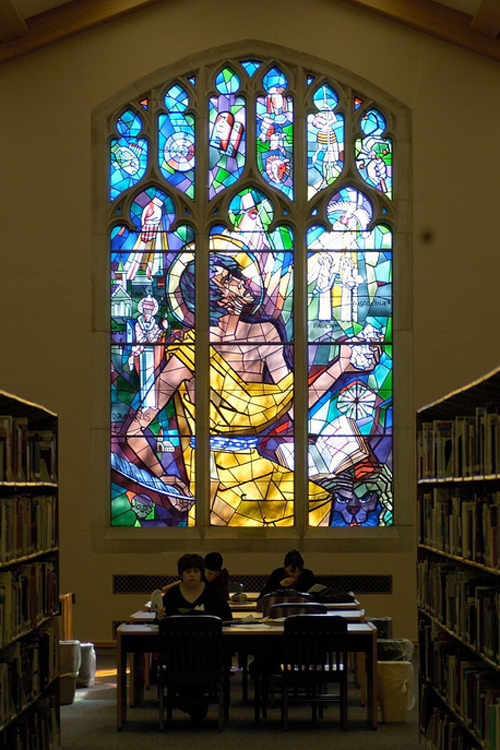Saint Jerome Window
The Saint Jerome Window is a large stained glass window that resides in the Reading Room of the Lorette Wilmot Library. In addition to having historical value, it provides tranquility, artistic beauty and natural light to the nearby study space.
The Saint Jerome Window was the gift of Theodore J. Zornow and Cyril R. Zornow. In memory of their father Theodore A. Zornow.
Learn More
Window Design
The design of the window is dominated by the figure of Jerome the hermit. Unlike the traditional "old man" of the desert, he is a young man in his thirties. The artist shows him in an attitude of intense meditation before the image of Christ Crucified. The Hand of God in the left section balances the symbol of the Holy Ghost at the right, thus completing the reference to the Trinity. Saint Jerome was an ardent defender of this mystery as well as of the divinity of Christ.
The left panel of the window features the Roman phase of Saint Jerome's life; the right panel refers to the period he spent in the Holy Land. The unifying figure of the saint moves into each panel through the device of his extended arms. The right hand holds a quill, stressing his voluminous sacred writings. The left hand clutches a rock, one of the instruments of his penance in the desert.
The upper sections are related to the life and work portrayed in the corresponding panels below. The fish (symbol of the Church) refers to the baptism of Saint Jerome which took place at Rome, and the Chi Rho in triplicate is from an ancient mosaic to be found in the Roman catacombs. The center includes the Tablets of the Law detailed in the Old Testament, and the symbols of the four Evangelists representing the New Testament: Matthew (Man), Mark (Lion), Luke (Ox), and John (Eagle). In the upper right the scourge and the figure of a pilgrim refer to Saint Jerome's life as a hermit in the East.
The modern Roman Panorama forms a background for Pope Damasus who encouraged the saint in his greatest work - the translation of the Bible. The small church and skull are traditionally included in pictures of Jerome and reveal him as a great Christian ascetic as well as a learned Doctor of the Church. The inclusion of Paula and Eustochium pays tribute to the memory of two of the religious women who assisted him in his literary work in Bethlehem. On the double-spread page of the Bible appears the ringing phrase of Saint Peter attesting the divinity of Christ: "...Christ, the son of the living God..." Nearby shines the Star of Bethlehem, ornate and mysterious, a symbol of Jerome's preference for life in the Holy Land. At his knee is the docile, vigilant lion always associated with Saint Jerome in legendary art and a mark of the protection provided by God.
This window, the artist's conception of Saint Jerome, is an attempt to use leaded glass in its simplest terms. The glass is selected from the finest quality, unmatted, in colors suitable to the expression of the richness and glory of life in the fourth century. The leads form a rhythmic overtone of lines, supporting the glass and at the same time giving shape to the figures and symbols. Here is, in fact, a glass mural conceived in the hope that it will promote a greater appreciation of the Holy Bible whose translation was made possible to us through the holy life and the literary elegance of Saint Jerome.
The words in the window are "Tu Es Christus * Filius Dei Vivi" which translates as "Thou art Christ * the Son of the living God."
About Saint Jerome
Saint Jerome was born at Stridon in Dalmatia about 347 A.D. At Rome he received an education in philosophy, literature, and law and he acquired a great love for learning and research. After a serious illness he determined to devote himself and his intellectual gifts exclusively to the service of God.
In search of a perfect mode of life he traveled to the Holy Land and lived with the hermits of Syria, studying Hebrew and meditating on the Scriptures. He was ordained a priest at Antioch in 379, studied Origen's scriptural works at Constantinople and then returned to Rome.
There he became secretary to Pope Saint Damasus who encouraged him to make an authentic Latin translation of the Bible. He completed the New Testament and the Psalms in 384, and then set out again for the Holy Land. He settled at Bethlehem where he completed the translation of the Old Testament.
In this work he was assisted by two great Roman ladies, Saint Paula and her daughter, Saint Eustochium. Saint Jerome died about 420 A.D. His body rests in the Church of Saint Mary Major at Rome.
Saint Jerome's translation of the Bible, known as the Latin Vulgate, was the official version of the Bible for the Roman Catholic Church for over a thousand years. His great learning, his commentaries on Holy Scripture, and his zeal in defending the Church against all heresies of his time have earned him the title of Doctor of the Church.
About the Artist: John C. Menihan
The artist behind the Saint Jerome window was John C. Menihan. He was a prominent upstate artist and his biography was written by Nazareth's own Ron Netsky. This biography can be found here.

- Tiktok
- YouTube
- ZeeMee
© 2025 Nazareth University • Copyright/Privacy • Diversity • Student Right to Know • Employment